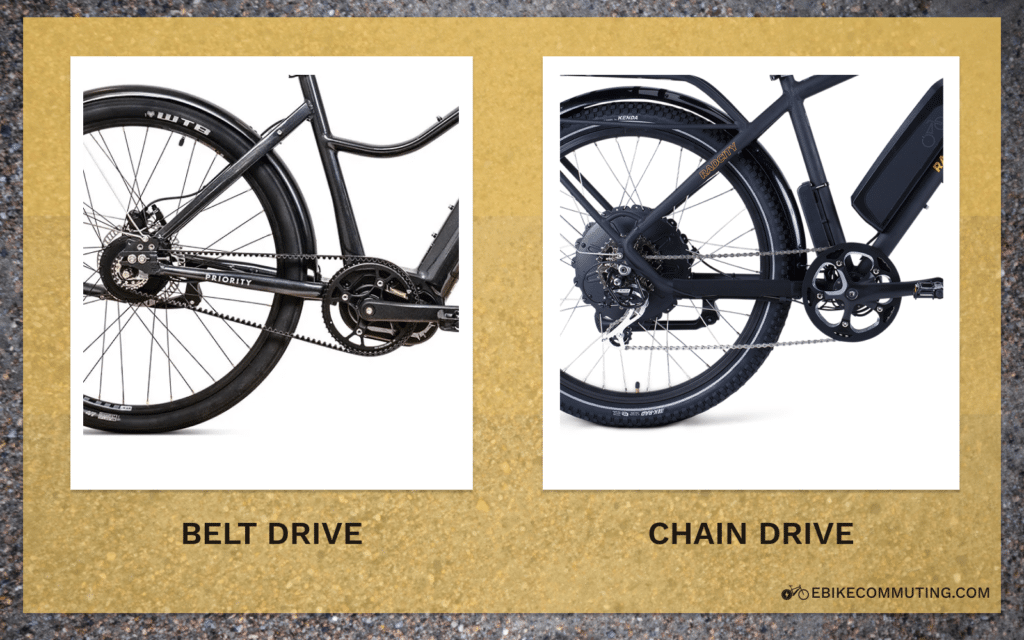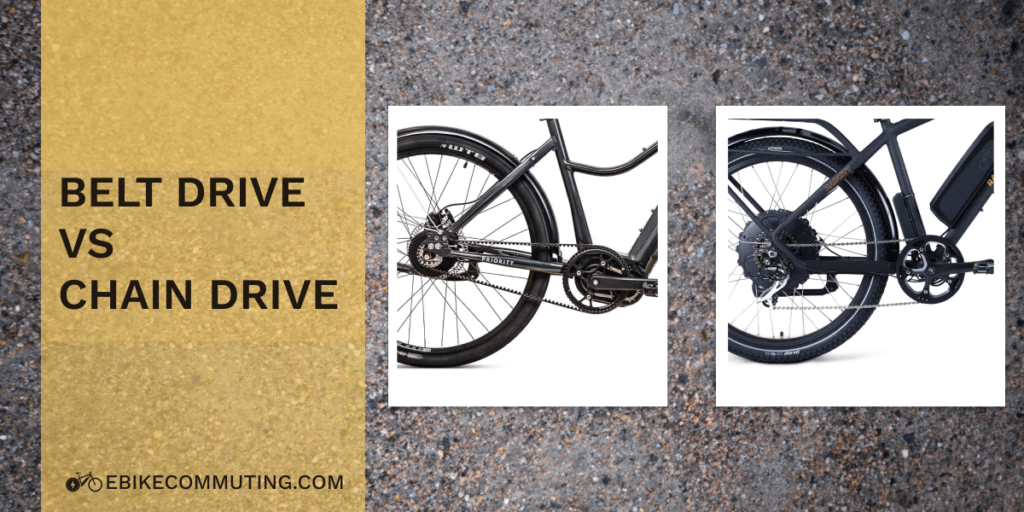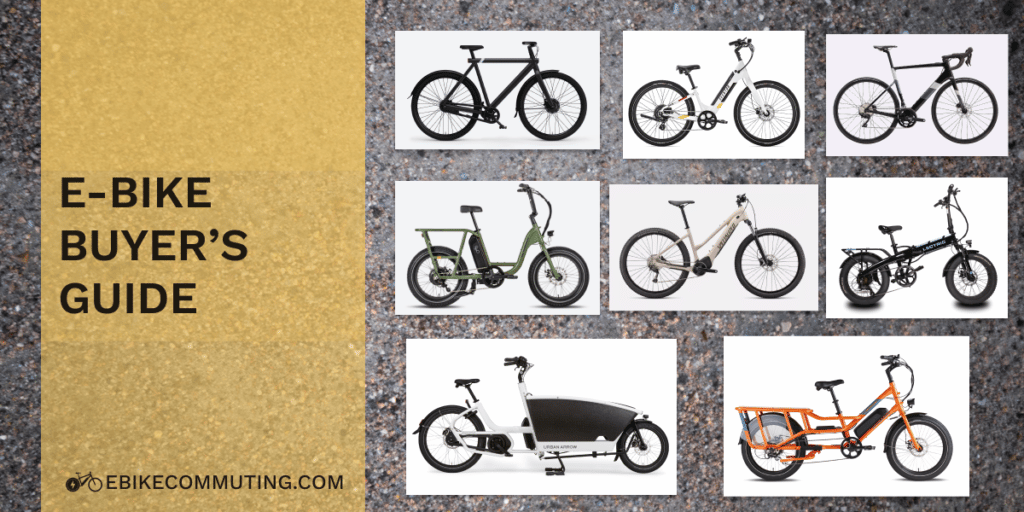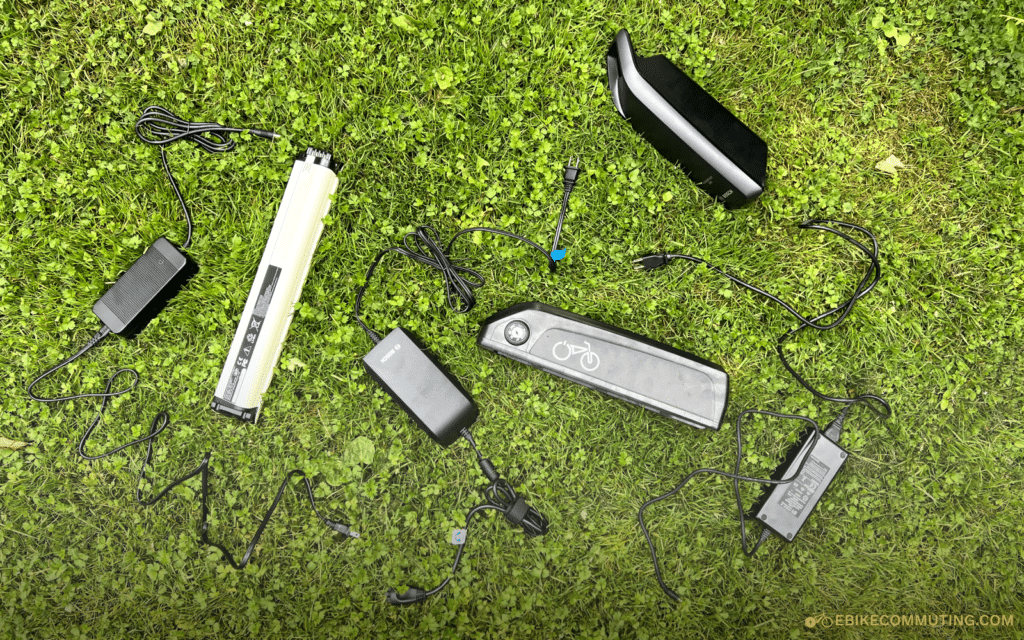E-bikes are becoming increasingly popular as a means of transportation due to their convenience and eco-friendliness. One important decision that individuals who are considering purchasing an e-bike must make is whether to opt for a belt drive or a chain drive system. Our preferred e-bike setup is a belt drive with internal gear hub. We believe this provides the best quality riding experience and the least amount of maintenance. The reduced maintenance is especially important to us because we are based in the rainy Pacific Northwest. The belt drive handles the rain and road grid like a champ. That being said, belt drives are more expensive.
Read this article for a comprehensive understanding of belt drives and chain drives for e-bikes, the advantages and disadvantages of each, and a performance and cost comparison.
Table of contents
Understanding Belt Drives and Chain Drives
E-bikes traditionally use either belt drives or chain drives to transmit power from the motor to the wheel. Both systems have their advantages and disadvantages, and choosing the right one can depend on a variety of factors such as cost, maintenance, and personal preference.
Components of Belt Drives
Belt drives are composed of several components that work together to transfer power efficiently and smoothly. The front sprocket, also known as the drive sprocket, is connected to the motor and provides the initial torque to the belt. The rear sprocket, also known as the driven sprocket, is connected to the wheel and receives the torque from the belt, which propels the bike forward. The belt is a flexible, toothed band made of materials such as carbon fiber or reinforced rubber that is reinforced with steel cords for durability. The sprockets, also known as pulleys, are connected to the motor and wheel and provide the teeth to grip the belt. The tensioner maintains belt tension, which is crucial to ensure proper power transfer.
The most well regarded manufacturer of belt drives for e-bikes is Gates Carbon Drive. Gates has been making top-quality belts for over 100 years. If the belt drive e-bike you are selecting comes with a Gates Carbon belt drive then you know you are getting a drive system that will last a long time.
Components of Chain Drives
Chain drives also consist of several components that work together to transfer power from the motor to the wheel. The front sprocket, also known as the chainring, is connected to the motor and provides the initial torque to the chain. The rear sprocket, also known as the cassette, is connected to the wheel and receives the torque from the chain, which propels the bike forward. The chain is made of metal and wraps around the sprockets to transfer torque. The derailleur is responsible for shifting the chain between different size sprockets to adjust to changes in terrain or speed. Chain drives require lubrication to prevent rust and reduce friction, which can increase maintenance requirements and costs.

Advantages and Disadvantages of Belt Drives
Now, let’s walk through the pros and cons of belt drives.
Pros of Belt Drives
One of the main advantages of belt drives is that they are super smooth to pedal compared to chain drives. This makes for a very enjoyable riding experience.
Another advantage of belt drives is that they require less maintenance and do not require lubrication, making them a cleaner option. This can save time and money on maintenance costs. This is especially true if you plan to ride your e-bike in wet weather. Belt drives handle rain and grit from city streets really well.
Belt drives are also more efficient than chain drives, as they experience less energy loss due to flexion and friction. This means that they can transfer more power with less energy input.
Cons of Belt Drives
Belt drives are typically more expensive than chain drives due to the cost of materials and manufacturing. This can make them a less attractive option for applications where cost is a primary concern.
It can be more challenging to change a rear-wheel flat when you have a belt drive because belt drives requires optimal tightening of the belt for maximum efficiency. This means you often spend extra time fiddling with getting the rear wheel into the correct position.
Advantages and Disadvantages of Chain Drives
Next, the pros and cons of chain drives.
Pros of Chain Drives
First, and probably the biggest pro of chain drives, is that they are much more cost-effective than belt drives and are widely available. The majority of e-bikes come with chain drives.
If a chain gets damaged it can easily be replaced and repaired.
Cons of Chain Drives
One of the biggest drawbacks of a chain drive is that it requires frequent maintenance and lubrication to prevent rust and reduce friction. If you will be riding your e-bike in the rain then you should plan to clean and grease your chain weekly.
Also, chain drives are noisier than belt drives and produce a distinctive clicking sound during operation. Not a huge deal, but something to be aware of.
Finally, chain drives are slightly less efficient than belt drives and experience energy loss due to friction and flexion.
Cost Analysis
When it comes to choosing between belt drives and chain drives for e-bikes, cost is often a major factor to consider. Let’s take a closer look at the initial investment and long-term costs associated with each option.
Initial Investment
While belt drives are known for their efficiency and reduced maintenance costs, they often come with a higher initial investment cost. This is due to the cost of materials and manufacturing. However, it’s important to keep in mind that the initial investment cost may be worth it in the long run. The efficiency of a belt drive system can lead to cost savings over time.
Long-term Costs
On the other hand, chain drives are generally less expensive than belt drives and have lower maintenance costs. However, the need for frequent lubrication and potential need for replacement or repairs can result in long-term costs. Additionally, chain drives may experience higher levels of energy loss and reduced battery life, resulting in potential long-term costs.
It’s also worth noting that the long-term costs of both belt drives and chain drives can vary depending on the specific e-bike requirements and usage. For example, if an e-bike is used frequently for long-distance rides, the long-term costs of a chain drive may be higher due to the need for more frequent maintenance and potential repairs.
Ultimately, the decision between belt drives and chain drives for e-bikes will depend on individual rider preferences, budget, and specific e-bike requirements. Both systems have their advantages and disadvantages, and the appropriate choice will depend on the rider’s needs and preferences.
When making a decision between belt drives and chain drives, it’s important to consider not only the initial investment and long-term costs, but also factors such as durability, efficiency, and overall performance. By carefully weighing all of these factors, riders can make an informed decision that will lead to a more enjoyable and cost-effective e-bike experience.
Bottom Line
If it’s within your budget, go with a belt drive and internal gear hub. I made the switch to a belt drive e-bike earlier this year and it’s been great. I love the super smooth pedaling feel and it’s especially nice when I ride in the wet Seattle weather. Previously on my chain drive e-bike I would clean and grease every week in the winter to keep it running smoothly. Now, with the belt drive I don’t have to worry about that. Definitely a time saver.
Check out our article on The Best Belt Drive E-Bike For Commutes in 2023!


